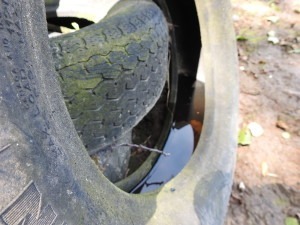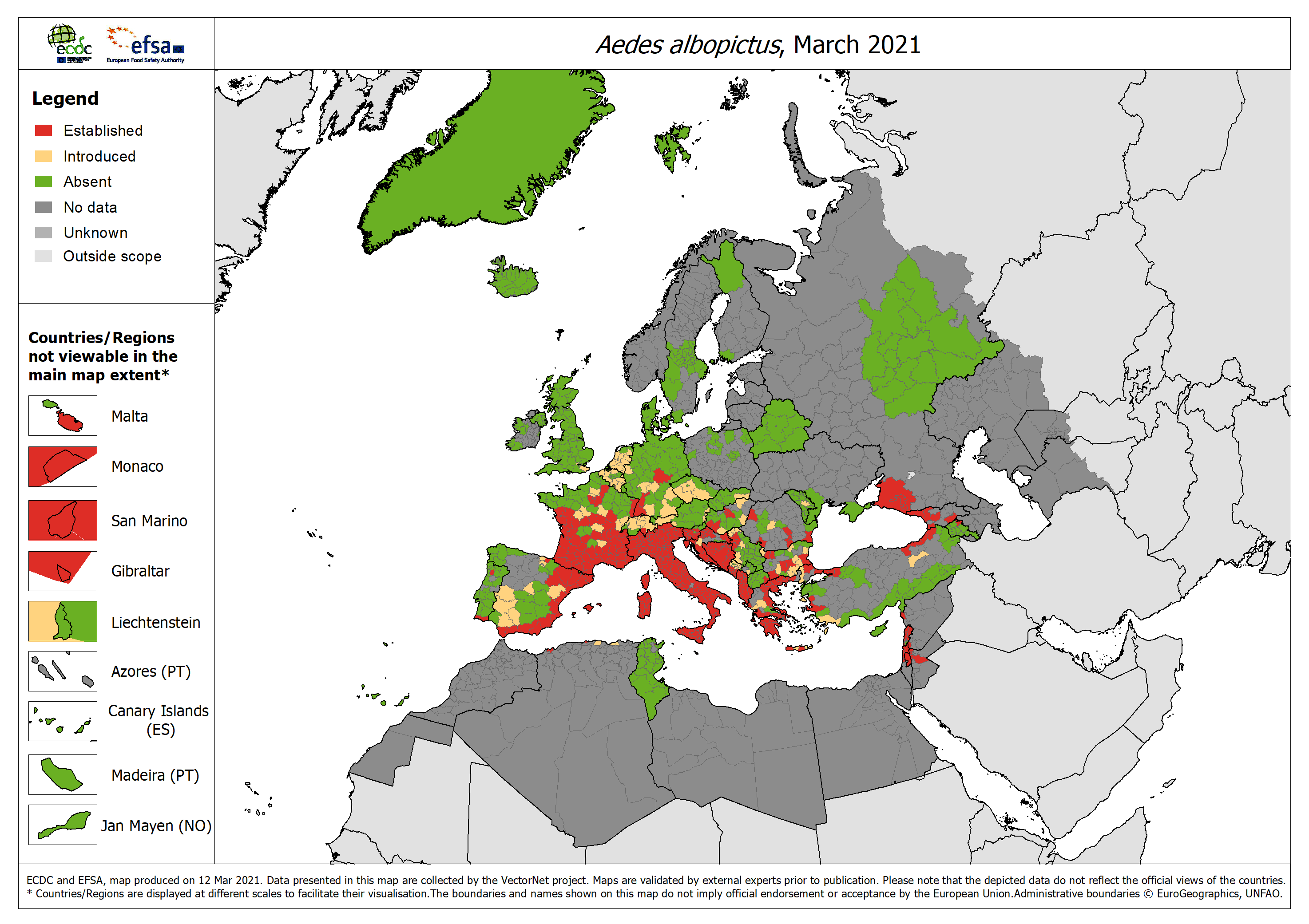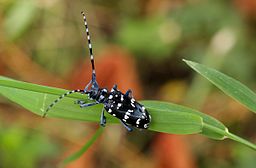 |
Asian tiger mosquito |
Status LU: introduced. 1st record: 2022. |
 |
Wäissgezeechent Iergermustik |
Status Eur.: established. 1st record: 1979. |
 |
Moustique tigre asiatique |
RA: ISEIA: C1. Harmonia+: 0,27. |
 |
Asiatische Tigermücke |
Wikipedia:    | Wikispecies: | Wikispecies:  | CABI | CABI |
 |
Aziatische tijgermug |
Back to the list of invertebrates |
Brief description
 Aedes albopictus (Skuse, 1895) is a mosquito native to the tropical and subtropical areas of Southeast Asia; however, in the past few decades, this species has spread to many countries through the transport of goods and international travel. It is characterized by the white bands on its legs and body. The first establishment in Europe occurred in 1979 in Albania (Adhami and Reiter 1998), next in 1990 in Genoa, Italy (Sabatini et al. 1990).
Aedes albopictus (Skuse, 1895) is a mosquito native to the tropical and subtropical areas of Southeast Asia; however, in the past few decades, this species has spread to many countries through the transport of goods and international travel. It is characterized by the white bands on its legs and body. The first establishment in Europe occurred in 1979 in Albania (Adhami and Reiter 1998), next in 1990 in Genoa, Italy (Sabatini et al. 1990).
This mosquito has become a significant pest in many communities because it closely associates with humans (rather than living in wetlands), and typically flies and feeds in the daytime in addition to at dusk and dawn. The insect is called a tiger mosquito for its striped appearance, which resembles that of the tiger. Ae. albopictus is an epidemiologically important vector for the transmission of many viral pathogens, including the yellow fever virus, dengue fever, and Chikungunya fever, as well as several filarial nematodes such as Dirofilaria immitis. Aedes albopictus is capable of hosting the Zika virus and is considered a potential vector for Zika transmission among humans (Wikipedia contributors 2020).

Potential breeding site for the Asian tiger mosquito.
Invasions of the Asian tiger mosquito into new areas of its potential range are often initiated through the transportation of eggs via the international trade in used tires (due to the rainwater retained in the tires when stored outside).
Advice for the population
Please refer to the Internet page https://mosquitoes.lu/dealing-with-mosquitoes/ for detailed information in 5 languages (



 ) on how to deal with mosquitoes near your home.
) on how to deal with mosquitoes near your home.
Status and distribution in Luxembourg
On on 2022-09-03, the Luxembourg Ministry of Health informs that a population of the tiger mosquito “Aedes albopictus” has been detected at two locations in the territory of the Commune of Roeser.
On on 2023-07-31, the Luxembourg Ministry of Health informs that eggs of the tiger mosquito “Aedes albopictus” have been detected near Capellen (Municipality of Mamer) in the week of 17-23 July 2023. This is the second detection of the invasive Asian tiger mosquito Aedes albopictus in Luxembourg.
Until September 2022 there was no documented occurrence of Aedes albopictus (Skuse, 1895) in Luxembourg yet (MNHNL, iNaturalist & GBIF 2021). The species has established itself in Alsace (France) and in Oestrich-Winkel near Mainz (Germany), about 150 km from the borders of Luxembourg. The species is regularly introduced into our neighbouring regions (Belgium and Holland, Lorraine, Rhineland-Palatinate) but is not yet established there thanks to monitoring and treatment of sites. An egg clutch was observed in August 2018 on a motorway rest area near Arlon (Belgium). Immediate site treatment prevented the development of a local population.
As of 2021, we estimated the arrival of the species in Luxembourg to be imminent.

The map shows the current known distribution of Aedes albopictus in Europe at at ‘regional’ administrative level (NUTS3), as of March 2021 (ECDC & EFSA, 2021).
From May to November, 2020, five ovitraps have been placed on the motorway service areas “Aire de Berchem (Est)” and “Aire de Capellen (Nord)” in order to survey the invasive Asian tiger mosquito Aedes albopictus. Both highways A3 and A6 are considered to be putative mosquito hitchhikers’ entry pathways into Luxembourg. The traps have been monitored over 23 weeks producing a total of 80 data. No mosquito eggs could be found in any sample. This surveillance was carried out as part of the international AIMSurv2020 project in the frame of the EU COST action CA17108 “Aedes Invasive Mosquitoes” (Ries & Schaffner 2020).
In 2016, the National Natural History Museum carried out a survey on mosquito species in Luxembourg. In July and August, ten mosquito traps were installed in different locations throughout the country. The BG-Sentinel 2 traps from the company Biogents were run for 24 hours once every week until the end of October. The catch was preserved in deep freezers and transferred to the Museum for identification. The catch was identified by mosquito specialist Dr. Francis Schaffner, University of Zurich. No invasive species were found among the caught specimens (Ries et al. 2019).
A public petition (n°1071) for a public health policy that effectively combats the implantation of tiger mosquitoes, vectors of diseases, in Luxembourg, was introduced on 10th July 2018 and was open for signatures until 19th September 2018 (Sarno Bomfim 2018).
Risk assessment
ISEIA protocol
C1 (2+3+1+1), reassessed on 3rd September 2022 by C. Ries. Originally assessed C0 (2+3+1+1) (Ries et al. 2017: 68).
Harmonia+ protocol
Overall risk score 0,27 = (Overall Invasion score 0,47 x Overall Impact score 0,58) (Schaffner & Ries 2019: 178).
0,47


Invasion
0,58


Impact
0,27


Risk
Worldwide distribution
Bibliography
- Adhami, J. & P. Reiter, 1998. Introduction and establishment of Aedes (Stegomyia) albopictus Skuse (Diptera: Culicidae) in Albania. Journal of the American Mosquito Control Association 14(3): 340–343.
- Boukraa, S., Dekoninck, W., Versteirt, V., Schaffner, F., Coosemans, M., Haubruge, E., Francis, F., 2015. Updated checklist of the mosquitoes (Diptera: Culicidae) of Belgium. Journal of Vector Ecology, 40(2), 398-407. [doi: 10.1111/jvec.12180]
- CABI, 2019. Aedes albopictus (Skuse, 1895). In: Invasive Species Compendium. Wallingford, UK: CAB International. URL: www.cabi.org/isc [accessed 2020-04-06]
- ECDC & EFSA, 2021. European Centre for Disease Prevention and Control and European Food Safety Authority. Mosquito maps [internet]. Stockholm: ECDC; 2021. Available from: https://ecdc.europa.eu/en/disease-vectors/surveillance-and-disease-data/mosquito-maps
- Ganser, J., 2020. Tigermücke im Anflug. Exotische Stechfliegen finden vermehrt den Weg nach Luxemburg. Das muss aber kein Grund zur Panik sein. Luxemburger Wort online 2020-09-21. URL: https://www.wort.lu/de/lokales/tigermuecke-im-anflug-5f68bdc4de135b9236d06c07
- MNHNL, iNaturalist & GBIF, 2021. Aedes albopictus (Skuse, 1895) in MNHNL-mdata, online portal combining species observation from Recorder-Lux, iNaturalist and GBIF. National Museum of Natural History, Luxembourg. URL: https://mdata.mnhn.lu [accessed 2021-09-03]
- Ries, C., A. Arendt, C. Braunert, S. Christian, A. Dohet, A. Frantz, G. Geimer, M. Hellers, J. A. Massard, X. Mestdagh, R. Proess, N. Schneider & M. Pfeiffenschneider, 2017. Environmental impact assessment and black, watch and alert list classification after the ISEIA Protocol of invertebrates in Luxembourg. Bull. Soc. Nat. luxemb. 119: 63-70. [PDF 360 KB]
- Ries, C. & F. Schaffner, 2020. Surveillance of Aedes albopictus (Skuse, 1895) (Diptera, Culicidae) on two motorway service areas in Luxembourg in 2020. A project report, unpublished, 10 p. [PDF 1.1 MB]
- Ries, C., S. Christian, M. Pfeiffenschneider, I.A. Giantsis & F. Schaffner, 2019. A survey of mosquito species (Diptera, Culicidae) in Luxembourg, 2016. Project report. Luxembourg: Musée national d’histoire naturelle. 7 pp. DOI: 10.13140/RG.2.2.22645.70884 [PDF 725 KB]
- Sabatini, A., Rainieri V., Trovato G. & Coluzzi M., 1990. Aedes albopictus in Italia e possibile diffusione della specie nell’area mediterranea. Parassitologia 32(3): 301–304.
- Sarno Bomfim, JA, 2018. – Pour une politique de santé publique qui combatte effectivement l’implantation des moustiques tigres, vecteurs de maladies, au Luxembourg. URL: https://chd.lu/wps/portal/public/Accueil/TravailALaChambre/Petitions/RoleDesPetitions?action=doPetitionDetail&id=1274 [08/08/2018].
- Schaffner, F. & C. Ries, 2019. First evidence and distribution of the invasive alien mosquito Aedes japonicus (Theobald, 1901) in Luxembourg. Bull. Soc. Nat. luxemb. 121: 169-183. [PDF 8,94 MB]
- Théry, P., 2018. Le moustique-tigre pourrait bientôt arriver. L’essentiel en ligne du 17 mai 2018.
- Wikipedia contributors, 2020. Aedes albopictus. Wikipedia, The Free Encyclopedia. URL: https://en.wikipedia.org/w/index.php?title=Aedes_albopictus&oldid=947251873 [accessed 2020-04-06]
Page content last updated on 2023-07-31. Last proofread by Caroline Grounds on 2019-12-04.





 Anoplophora chinensis (Forster, 1771) originates from Eastern Asia where it seriously damages forest and agricultural plant hosts. Since the the citrus longhorn beetle is listed in annex V of the Council Directive 2000/29/EC of 8 May 2000 on protective measures against the introduction into the Community of organisms harmful to plants or plant products and against their spread within the Community, the competent administration informs about the species and the consequences of the listing (Anonymous [undated]).
Anoplophora chinensis (Forster, 1771) originates from Eastern Asia where it seriously damages forest and agricultural plant hosts. Since the the citrus longhorn beetle is listed in annex V of the Council Directive 2000/29/EC of 8 May 2000 on protective measures against the introduction into the Community of organisms harmful to plants or plant products and against their spread within the Community, the competent administration informs about the species and the consequences of the listing (Anonymous [undated]).
 Invasion
Invasion
 Impact
Impact
 Risk
Risk






























